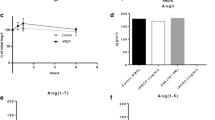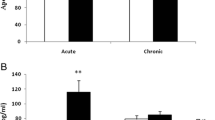Abstract
Background
In order to clarify the interaction between cardiac dysfunction and sodium homeostasis in the kidney, we used a murine model of cardiac dysfunction and investigated the effect on sodium transporters in renal tubular cells.
Methods
Cardiac function was deteriorated by abdominal aortic banding, and the gene expression of sodium transporters in the kidneys was evaluated by real-time RT-PCR and compared with that in the kidneys of control mice.
Results
Gene expression of all three variants of the murine prolactin receptor was enhanced by aortic banding. Upregulated prolactin receptor was distributed in the proximal tubular cells of the pars recta in the deep inner cortex and the outer stripe of the outer medulla. Prolactin has been reported to be a natriuretic hormone that inhibits proximal tubular Na+/K+-ATPase activity, resulting in reduced sodium reabsorption and the acceleration of natriuresis. Inhibition of endogenous prolactin secretion by bromocriptine administration decreased the urine sodium excretion in both aortic banding and control mice. On the other hand, excess exogenous prolactin administration enhanced urine potassium excretion in aortic banding mice. Furthermore, a high-sodium diet accelerated urinary sodium excretion, which was also significantly decreased by inhibition of endogenous prolactin secretion in aortic banding mice.
Conclusion
We reported that the prolactin receptor was upregulated by aortic banding treatment. Prolactin-prolactin receptor interaction in the proximal tubular cells of the pars recta should involve a different mechanism of kaliuresis other than inhibition of Na+/K+-ATPase.








Similar content being viewed by others
References
Ronco C, Haapio M, House AA, Anavekar N, Bellomo R. Cardiorenal syndrome. J Am Coll Cardiol. 2008;52:1527–39.
Stefanadis CI. Complex interrelationships between heart and kidneys: establishing the role of cardiorenal syndrome. Hell J Cardiol. 2010;51:87–8.
Bongartz LG, Cramer MJ, Doevendans PA, Joles JA, Braam B. The severe cardiorenal syndrome: ‘Guyton revisited’. Eur Heart J. 2005;26:11–7.
Akishita M, Iwai M, Wu L, Zhang L, Ouchi Y, Dzau VJ, et al. Inhibitory effect of angiotensin II type 2 receptor on coronary arterial remodeling after aortic banding in mice. Circulation. 2000;102:1684–9.
Hara M, Ono K, Hwang M-W, Iwasaki A, Okada M, Nakatani K, et al. Evidence for a role of mast cells in the evolution to congestive heart failure. J Exp Med. 2002;195:375–81.
Yayama K, Hiyoshi H, Imazu D, Okamoto H. Angiotensin II stimulates endothelial NO synthase phosphorylation in thoracic aorta of mice with abdominal aortic banding via type 2 receptor. Hypertension. 2006;48:958–64.
McCormick SD, Bradshaw D. Hormonal control of salt and water balance in vertebrates. Gen Comp Endocrinol. 2006;147:3–8.
Pickford GE, Griffith RW, Torretti J, Hendlez E, Epstein FH. Branchial reduction and renal stimulation of (Na+, K+)-ATPase by prolactin in hypophysectomized killfish in fresh water. Nature. 1970;228:378–9.
Pippard C, Baylis PH. Prolactin stimulates Na+-K+-ATPase activity located in the outer renal medulla of the rat. J Endocrinol. 1986;108:95–9.
Ibarra F, Crambert S, Eklöf A-C, Lundquist A, Hansell P, Holtbäck U. Prolactin, a natriuretic hormone, interacting with the renal dopamine system. Kidney Int. 2005;68:1700–7.
Crambert S, Sjöberg A, Eklöf A-C, Ibarra F, Holtbäck U. Prolactin and dopamine 1-like receptor interaction in renal proximal tubular cells. Am J Physiol Renal Physiol. 2010;299:F49–54.
Sakai Y, Hiraoka Y, Ogawa M, Takeuchi Y, Aiso S. The prolactin gene is expressed in the mouse kidney. Kidney Int. 1999;55:833–40.
Binart N, Bachelot A, Bouilly J. Impact of prolactin receptor isoforms on reproduction. Trends Endocrinol Metab. 2010;21:362–8.
Bole-Feysot C, Goffin V, Edery M, Binart N, Kelly PA. Prolactin (PRL) and its receptor: actions, signal transduction pathways and phenotypes observed in PRL receptor knockout mice. Endocr Rev. 1998;19:225–68.
Leichtweiss HP, Lübbers DW, Weiss CH, Baumgärtl H, Reschke W. The oxygen supply of the rat kidney: measurements of intrarenal pO2. Pflügers Arch. 1969;309:328–49.
Levy MN, Imperial ES. Oxygen shunting in renal cortical and medullary capillaries. Am J Physiol. 1961;200:159–62.
Vetterlein F, Pethö A, Schmidt G. Distribution of capillary blood flow in rat kidney during postischemic renal failure. Am J Physiol. 1986;251:H510–9.
Hellberg POA, Källskog Ö, Wolgast M. Red cell trapping and postischemic renal blood flow. Differences between the cortex, outer and inner medulla. Kidney Int. 1991;40:625–31.
Freeman ME, Kanyicska B, Lerant A, Nagy G. Prolactin: structure, function, and regulation of secretion. Physiol Rev. 2000;80:1523–631.
Devi YS, Shehu A, Stocco C, Halperin J, Le J, Seibold AM, et al. Regulation of transcription factors and repression of Sp1 by prolactin signaling through the short isoform of its cognate receptor. Endocrinology. 2009;150:3327–35.
Katz AI, Doucet A, Morel F. Na-K-ATPase activity along the rabbit, rat, and mouse nephron. Am J Physiol. 1979;237:F114–20.
Goffin V, Bernichtein S, Touraine P, Kelly PA. Development and potential clinical uses of human prolactin receptor antagonists. Endocr Rev. 2005;26:400–22.
Tanaka M, Yoshida H, Furuhashi M, Togashi N, Koyama M, Yamamoto S, et al. Deterioration of renal function by chronic heart failure is associated with congestion and oxidative stress in the tubulointerstitium. Intern Med. 2011;50:2877–87.
Matsumoto M, Tanaka T, Yamamoto T, Noiri E, Miyata T, Inagi R, et al. Hypoperfusion of peritubular capillaries induces chronic hypoxia before progression of tubulointerstitial injury in a progressive model of rat glomerulonephritis. J Am Soc Nephrol. 2004;15:1574–81.
Hu ZZ, Zhuang L, Meng J, Dufau ML. Transcriptional regulation of the generic promoter III of the rat prolactin receptor gene by C/EBPβ and Sp1. J Biol Chem. 1998;40:26225–35.
Hirata M, Kugimiya F, Fukai A, Saito T, Yano F, Ikeda T, et al. C/EBPβ and RUNX2 cooperate to degrade cartilage with MMP-13 and the target and HIF-2α as the inducer in chondrocytes. Hum Mol Genet. 2012;21:1111–23.
Koizume S, Ito S, Miyagi E, Hirahara F, Nakamura Y, Sakuma Y, et al. HIF2α-Sp1 interaction mediates a deacetylation-dependent FVII-gene activation under hypoxic conditions in ovarian cancer cells. Nucleic Acids Res. 2012;40:5389–401.
Nangaku M, Inagi R, Miyata T, Fujita T. Hypoxia and hypoxia-inducible factor in renal disease. Nephron Exp Nephron. 2008;110:e1–7.
Acknowledgments
We are grateful for the excellent technical support of N. Imai, K. Yamagiwa, K. Minowa, H. Aita, and T. Watanabe at the Division of Clinical Nephrology and Rheumatology and F. Higuchi at the Division of Applied Molecular Medicine, Niigata University Graduate School of Medical and Dental Sciences. This study was supported by a Grant for the Promotion of Niigata University Research Projects to Y. K.
Conflict of interest
All the authors have declared no competing interests.
Author information
Authors and Affiliations
Corresponding author
About this article
Cite this article
Tsuchida, Y., Kaneko, Y., Otsuka, T. et al. Upregulation of prolactin receptor in proximal tubular cells was induced in cardiac dysfunction model mice. Clin Exp Nephrol 18, 65–74 (2014). https://doi.org/10.1007/s10157-013-0820-x
Received:
Accepted:
Published:
Issue Date:
DOI: https://doi.org/10.1007/s10157-013-0820-x




